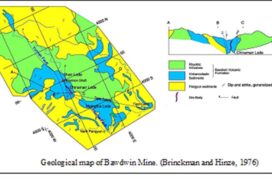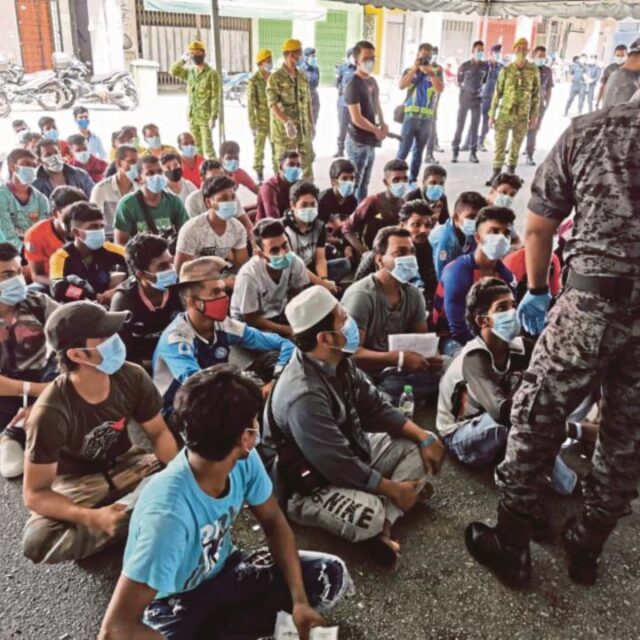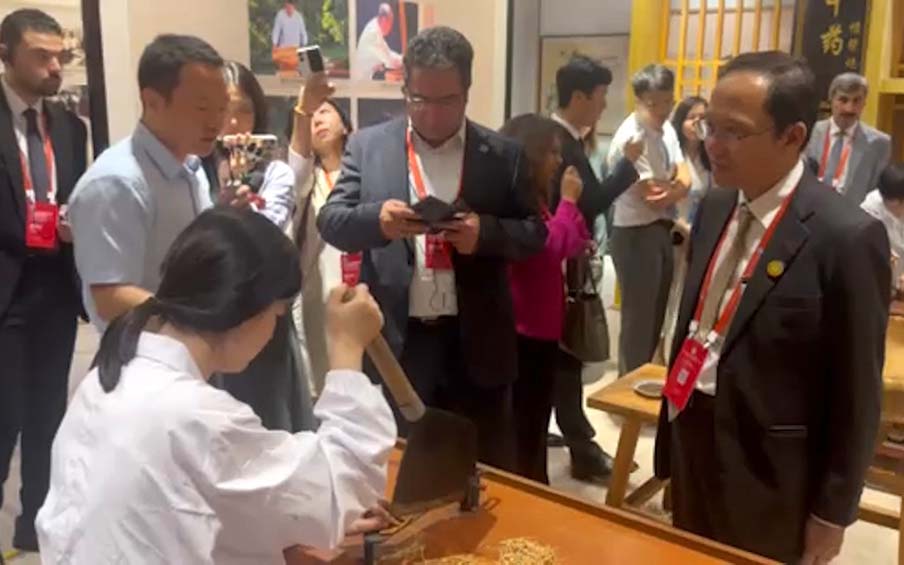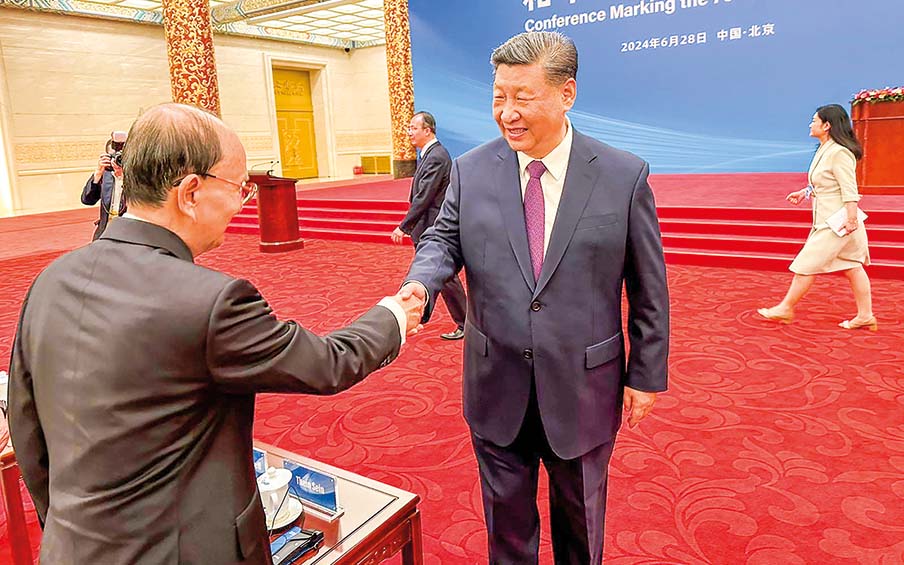EPISODE:37
By THAN HTUN (GEOSCIENCE
MYANMAR)
Geology and Ore Deposits of the Bawdwin Mines
This episode is the continuation of the previous Episode 36 and provides a summary of the mineralogy of the ore deposits of Bawdwin Mines reported by J Coggin Brown in 1917.
Mineralogy of the Ore Deposits
Only those minerals that are of interest in connection with the ore deposits are described.
Silver: Native silver, in its characteristic moss-like aggregates and plates, has been reported by the Goldhole gossan.
Copper: On the waste heaps of the Goldhole adit, I found native copper in thin films and dendritic growths associated with brecciated white quartz. Occasionally, the quartz is held together by the copper, which has been deposited in the network of irregular cracks that traverse it. The metal is either dark and tarnished or else stained blue from its basic hydration products. Dendritic native copper has also been found at the edge of the Chinaman ore body in the zero level (south drive 207 feet east at 1,500 feet south), associated with a very kaolinized tuff.
Galena: The isometric sulphide of lead is except zinc blende, the most important mineral of the Bawdwin area. The long series of assays now available show that it carries all the silver present in the mixed ore, which is highly argentiferous. There is practically no gangue associated with the high-grade lead-zinc ore of the Chinaman lode. In the lower-grade ores, the sulphide occurs as irregular grains disseminated through kaolinized and sericitized tuffs. Chalcopyrite and pyrite also occur as grains disseminated through the lead and zinc sulphides. The rich ore very often exhibits cleavage, slipping planes, banding, schistosity, and curved cleavage of the individual grains, conditions probably due to pressure. The galena oxidizes to cerussite and anglesite.
Chalcocite: Copper glance, or cuprous sulphide, has been found associated with covellite, both in the Goldhole level and in the upper parts of the Chinaman lode.
Corellite: Cupric sulphide forms a thin film of flexible plates of dark indigo-blue colour on pieces of zinc ore from the ancient workings of the Chinaman lode. Both chalcocite and covellite were first recognized by Mr H C Jones, Curator of the Geological Survey of India, on specimens submitted to him for examination. They both occur in minute quantities and are of no economic importance.
Melaconite: Cupric oxide, CuO A black pulverulent mineral from the face of the Goldhole working has proved on examination to be melaconite.
Zinc Blende: This is always associated with the galena and often with small amounts of pyrite and chalcopyrite. In the ribbon-ore, it occurs in thin regular bands of a brownish-black colour. At the bottom of the internal shaft in April 1915, a massive fine-grained zinc blende with a pitchy lustre was met with. Pieces of resin blende of light brown colour were picked up on the vertical shaft dumps; they showed numerous minute cracks filled with pyrite.
Calamine: Small quantities of zinc carbonate have been detected with other oxidation products in the upper at Bawdwin.
Chalcopyrite: Copper pyrites are distributed sparingly through much of the high-grade ore and occur in some quantity in the Shan lode in the massive condition often associated with calcite.
Pyrites: Iron disulphide FeS2 is common in small grains throughout the Chinaman ore body and abundant towards its peripheries, also filling cracks and hollows left by solution. Occasionally, it forms bunches, especially in the Goldhole.
Malachite: The green carbonate of copper is noticed in small quantities in the surface rocks of the ore channel. It usually occurs in thin lamellae along the shear planes of the country rock and is of no economic importance. It is especially common in the neighbourhood of the Dormouse Ravine and the Amphitheatre. It is invariably associated with azurite.
Azurite: The blue copper carbonate is found in thin films impregnating the decomposed rhyolite tuffs and in small groups of tabular crystals. Both carbonates are produced by the oxidation of the chalcopyrite.
Anglesite, Lead Sulphate: This is a common mineral in the zone of oxidation, though both anglesite and cerussite are found as crystals implanted on unaltered sulphide ore by solution percolating down from the zone of oxidation. The usual form assumed by anglesite crystals is that of a simple orthorhombic prism, elongated somewhat along the vertical axis and generally terminated by pyramidal faces. The Chinese probably mined anglesite; it is certainly of economic importance at Bawdwin today.
Cerussite: The carbonate of lead is found in association with anglesite and sometimes with malachite and azurite. It was one of the oxidized ores, though it does not now attain commercial importance. I have seen a few massive specimens made up of lustrous white crystals. Still, it is common in crevices and cavities in the sulphide zone forming tabular penetration twins or, again, in minute fragile sparkling druses. The twins are often tinged blue or green by copper carbonates.
Massicot: Lead monoxide occurs as an impure earthy yellow powder in the oxidized zone in small quantities.
Pyromorphite: The phosphate and chloride of lead occur with anglesite on galena in the Dead Chinaman Tunnel as small prismatic crystals of a fawn colour that show a slight tendency to become barrel-shaped or to taper down to a point.
Goslarite: Zinc sulphate forms white crystals and incrustations on the walls of the upper levels in the Chinaman lode.
Brochantite: Basic copper sulphate forms blue crystals and incrustations in similar situations.
Barytes. Barium sulphate: Though not associated with the ore bodies themselves, this mineral is abundant in veins in the immediate neighbourhood of Bawdwin. It occurs in massive coarse-grained aggregates, which are often full of small cavities. The broken surfaces of these show a platy structure with curved surfaces and a vitreous lustre. It is found on the lip of the Amphitheatre and in large masses in that great excavation, which was originally an open-cut working but has been enlarged by landslips.
The Ores
The essential constituents of the Bawdwin ores, except the copper ores of the Shan lode, are galena and zinc blende, intimately intergrown and of a fine to medium grain. The sulphides, pyrite, and chalcopyrite are sparingly distributed through the zinc-lead ore, the latter being, for the most part, exceptional in the great mass of the ore rather than characteristic, though there is sometimes a concentration of this mineral on the hanging-wall side of the ore-body. For example, it occurs on the third level of the winze in this position, the winze itself being 300 feet north of the internal shaft. The galena-zinc blende ore is always argentiferous, and the richer the mixture is in galena, the higher the silver content is. A summation of the assays of the crude high sulphide ore of the 171 feet level shows 19.2 ounces of silver to the tonne of ore, 24 per cent of lead, and 20.7 per cent of zinc.
The high-grade ore is pure enough to be selectively won, handpicked, and shipped. The lower grades consisting of galena and zinc blend mixed with gangue will have to be crushed and concentrated locally to fit them for the market, which will add an increased charge to the working costs but decrease those due to transportation. The high-grade copper ores of the Shan lode can be handpicked and shipped or else smelted locally.
The gangue of the Chinaman ore body consists of metamorphosed country rock and little quartz. Every gradation can be found in pure mixed sulphides to tuffs, which show no signs of mineralization. In the second-grade ores, the galena is seen metasomatically replacing the altered felspars of the rock or even its groundmass, while both it and the blende from numerous ramifying veinlets crossing the rock in all directions and leaving little except the original irregular grains of quartz, which in the massive ore are replaced too. There can be no question that the greater part of the galena is of metasomatic origin, for the veinlets possess no regular fissure walls when seen under the microscope but are irregular in width, branching, and reticulating in all directions. It would appear, therefore, that the metallic sulphides attacked first of all the altered felspars of the tuffs and replaced them, among others.
At Bawdwin, the honeycombing of the upper parts of the ore channel for some hundreds of years by a perfect labyrinth of Chinese levels, crosscuts, winzes, rises, and stopes, and the slow decomposition of the timber introduced into them by the ancient miners, have not been without a potent effect in this direction. This can be seen at the zero level, in which the walls and roof are coated with thick growths of the sulphates of copper and zinc, and the heat produced by the oxidation of the sulphides in the old fill is unbearable.
Sometimes, I have found small pieces of rather coarse galena embedded in quartz, the crystalline structure of which is very well developed. Although it must be very closely associated with the replacement ore, this material is secondary and has been deposited in narrow open fissures in the main ore body. The steel ore has been produced by crushing and recrystallization of the sulphides by recent movements since the deposition of the ore. The occasional slickensiding of the rich ore proves the fact that these movements have occurred.
Order of deposition of the sulphides
In my earlier report on the Bawdwin Mines, I wrote, “The microscopic examination of various specimens shows that iron and copper sulphides, when present with the others, were the first to be formed, for they have been found in grains surrounded by galena, the converse arrangement not having been observed. In the case of lead and zinc sulphides, the relationships are somewhat ambiguous. Galena has been found surrounded by a zinc blend. The latter is by far the commoner case, and it may be assumed that, as a general rule, the zinc blende was deposited before the lead sulphide. In most of the sections examined, the two sulphides of lead and zinc occur in small grains scattered indiscriminately through the rock. It is remarkable, however, that in some instances, the sulphides are seen to be growing more or less separately, giving the ore a banded appearance under the microscope.” These were incomplete observations based on outcrop material or pieces of ore from the Chinese slag dumps. Later research on the Chinaman ore body in situ has forced me to slightly different conclusions, but even yet, it cannot be confidently asserted that the various minerals have always been deposited in the same way in different places or that the replacement by one particular sulphide went on for a certain period over a large area and was then followed by the deposition of another. Important as the study of the paragenesis of the minerals is, too much reliance must not be placed upon it as a record of a succession of simple events, among others.
The question is further complicated by the absence of banded deposits in which layers of minerals were successively deposited one on top of another. The investigation is confined to the microscopic examination of thin sections of the massive ores. With these reservations, I now believe that the general order of deposition commencing from the earliest formed was zinc blende, copper and iron sulphides, and then galena. However, the zinc blende at Bawdwin, although it seems to have been the first mineral formed, is restricted to a much narrower area than the galena, which is found far out into the walls on each side of the ore body. The common occurrence of pyrite in vugs and as implanted crystals on the deeper ore is either due to the redeposition of that mineral by descending solutions or a later generation of it by ascending ones.
Origin of the ores
The general conditions at Bawdwin, both in the ore channel and surrounding area, point to the fact that the ores are deposits from hot ascending solutions probably under pressure rising from considerable depths. We have seen that the ores were deposited in a faulted zone, which rendered the tuffs themselves permeable to the mineralizing solutions. What was the origin of the latter? In seeking an explanation of this question, I have derived much help from the hypothesis advanced to account for the source of the ores of the Coeur dÁlene district in Idaho by F L Ransome. In some ways, there is a distinct parallel between the two areas, though, of course, it is on a much smaller scale than in the case of Bawdwin. The prevailing country rock in the American field is a fine-grained sericitic quartzite of the pre-Cambrian age, and, though traversed by numerous faults of large displacement, the mineral veins follow subordinate fractures of no great throw. The ore deposits are composite veins or lodes, often of considerable thickness, formed partly by filling but largely by replacement along shear planes in sericitic quartzite. The ore shoots are large but irregular, and the shear zones are nearly vertical; galena, with some pyrite and zinc blende and in places, a little argentite, are the principal ore minerals.
I cannot believe that the Bawdwin ore deposits are unassociated with the presence of igneous rock, neither do I think it possible that the ores emanated from the same source as the rhyolites themselves in pre-Cambrian or early Cambrian times. This has led me to suppose that they are connected in some way with the Tawnpeng granite, among others.
As a working hypothesis, therefore, I conclude that the ore bodies at Bawdwin were formed by hot solutions from an underlying granitic magma, rising along shattered fault planes previously produced and replacing congenial rocks, such as the rhyolitic tuffs whenever they happened to lie in their lines of circulation. They were probably formed under considerable thickness of sedimentary strata, which have been eroded away, for it is a region of intense denudation, and they have been crushed and faulted in movements that have taken place since their formation.
References:
Brown Coggin J, 1917: Geology and Ore Deposits of the Bawdwin Mines, Records of the Geological Survey of India, Vol XLVIII, Part 3.














